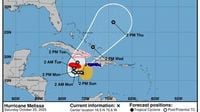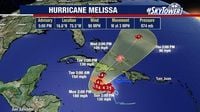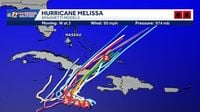As Hurricane Melissa barrels toward Jamaica, the Caribbean is bracing for a storm that meteorologists warn could become one of the most powerful and destructive in recent memory. With the storm’s center expected to make landfall early next week, residents across Jamaica, southern Hispaniola, and parts of Cuba are scrambling to prepare for what forecasters describe as a triple threat: catastrophic flooding, intense wind damage, and life-threatening storm surges.
According to the latest updates from the National Hurricane Center and reports from CNN, FOX 13, NPR, and Reuters, Hurricane Melissa rapidly intensified after becoming a hurricane on Saturday afternoon, October 25, 2025. As of the 5 p.m. advisory that day, the storm packed sustained winds of 90 miles per hour and was crawling westward at just three miles per hour. By Saturday evening, Melissa had strengthened to a Category 2 hurricane with top sustained winds of 100 miles per hour, and meteorologists expect it to reach Category 4 or even Category 5 strength by Monday, October 27.
Jamaica finds itself directly in the storm’s crosshairs. The island is under a hurricane warning, and officials warn that Melissa’s slow pace will only intensify its impacts. “It’s going to sit there pouring water while it’s barely moving. And that is a significant challenge that we have to be aware of,” said Evan Thompson, Director of the Meteorological Service of Jamaica, during a Saturday press briefing, as quoted by NPR. Thompson cautioned that Melissa could be even worse than Hurricane Wilma, which battered Jamaica in 2005. “It’s going to cause significant, widespread, catastrophic, life-threatening floods, as long as what is predicted does take place.”
The National Hurricane Center forecasts that Melissa will make landfall in Jamaica early in the week, with the worst effects likely to be felt between Monday and Wednesday. Rainfall totals are expected to be staggering: 15 to 30 inches across Jamaica and parts of southern Hispaniola, with some areas potentially receiving up to 40 inches. Such deluges, combined with the hurricane’s slow movement, raise the risk of prolonged flash flooding and deadly landslides. At least one person has already died in the Dominican Republic, and three more in Haiti, due to landslides and falling trees linked to the storm.
Prime Minister Andrew Holness addressed Jamaicans in a national press conference, urging residents—especially those in low-lying areas like Port Royal in Kingston—to evacuate if possible. “I would urge all my fellow citizens, now is the time to be prepared,” Holness said, highlighting that “the entire Jamaica will be impacted” for multiple days. Despite the grave warnings, Holness stopped short of issuing a mandatory evacuation order.
Preparations are visible across the island. Fishermen and vendors in Kingston are racing to secure their boats and sell their goods before the storm’s arrival. “When it’s moving slow, it’s the worst because no one knows what’s next,” said Diane Thompson, a local herb seller, to Reuters. “I asked God this morning to see if he can turn back the storm. Because no matter what, we cannot manage it.” Clive Davis, a fisherman, echoed these anxieties: “But this now, she wants to come stay, visit Jamaica for three days, why? It’s gonna slow down business, but it’s nature. We can’t fight against nature.”
Jamaica’s National Water Commission has activated emergency protocols, prioritizing water supply to hospitals, children’s homes, and correctional facilities should the island’s water system be disrupted. The Jamaica Information Service also warned residents that floods may displace crocodiles from waterways, adding another layer of danger to the unfolding crisis.
The storm’s impacts won’t be limited to Jamaica. A hurricane watch is in effect for southwestern Haiti and parts of Cuba, including Granma, Santiago de Cuba, Guantanamo, and Holguin. Portions of Haiti are under tropical storm warnings, and the National Hurricane Center has issued a hurricane watch for the island nation from its border with the Dominican Republic to Port-au-Prince. The slow-moving hurricane is expected to bring 15 to 30 inches of rain to southern Hispaniola, with local maxima of 40 inches, increasing the risk of catastrophic flash floods and landslides in both Haiti and the Dominican Republic.
Eastern Cuba is also on high alert, with hurricane conditions expected between Tuesday and Wednesday. Rainfall totals there could reach 6 to 12 inches, with some areas seeing as much as 18 inches. The U.S. Navy has ordered the evacuation of non-essential personnel and families from the base at Guantanamo Bay as a precaution.
Storm surge is another major concern. Jamaica’s southern coast could see surges of up to 13 feet, accompanied by large, destructive waves, according to the National Hurricane Center. Significant storm surges are also expected along the southeast coast of Cuba early next week. Meteorologists warn that such surges, combined with torrential rainfall, could inundate coastal communities and overwhelm local infrastructure.
Forecast models have struggled to predict Melissa’s exact path due to its erratic movement over the past few days, but there is now broad agreement that Jamaica will bear the brunt of the storm. FOX 13 Meteorologist Nash Rhodes explained, “It’s going to move generally to the north and west over the next few days as it approaches Jamaica.” The storm is expected to be steered away from the United States and well east of Florida by an upper-level trough, but the Bahamas, Turks and Caicos, Hispaniola, Cuba, and Jamaica remain on high alert.
For many Jamaicans, the coming days are filled with uncertainty and anxiety. “Today is really the last day to do what you have to do on the outside,” Evan Thompson warned, urging residents to complete their preparations immediately. The storm’s slow speed and immense power mean its effects could linger for up to five days, disrupting daily life and threatening lives and property across the region.
As Hurricane Melissa closes in, the Caribbean faces a stern test of resilience and preparedness. With emergency protocols activated and communities on edge, the hope is that timely action and collective vigilance will help minimize the storm’s toll—even as nature’s fury bears down with relentless force.






